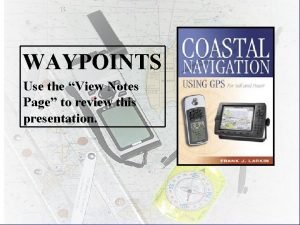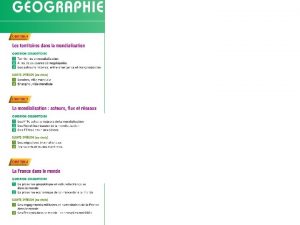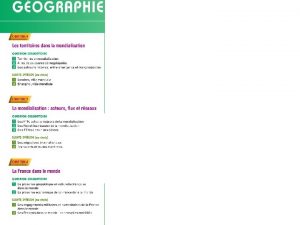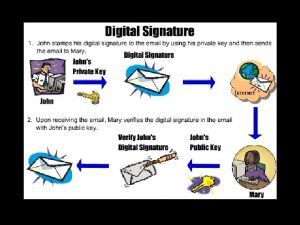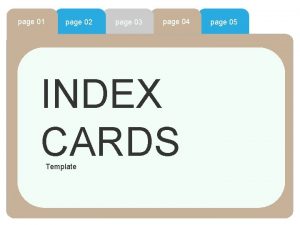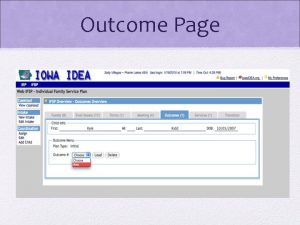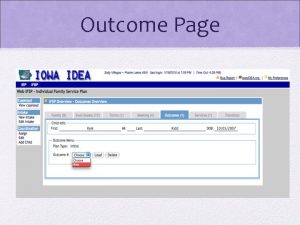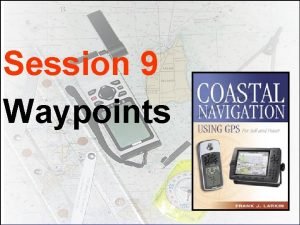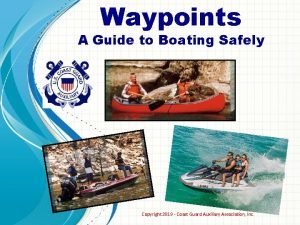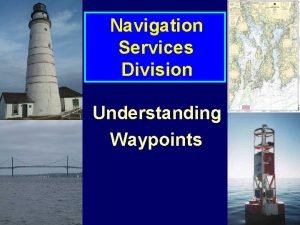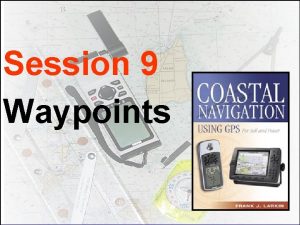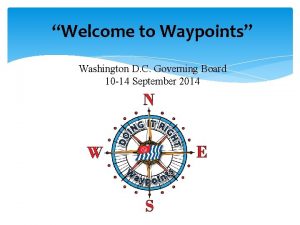WAYPOINTS Use the View Notes Page to review





































- Slides: 37

WAYPOINTS Use the “View Notes Page” to review this presentation.

GPS Tips Periodically verify your GPS location by using other methods. Use Aids to navigation as waypoints. Stay alert for GPS malfunctions.

Waypoint Screen Waypoint name Reference waypoint Bearing from reference waypoint Position coordinates Waypoint comment Distance from reference waypoint

1. Learn how to input waypoints. 2. Learn how to use waypoints.

A “WAYPOINT” (WPT or WP) is a designated location with geographic coordinates defined by latitude and longitude.

Source of Waypoints INPUT TO YOUR GPS: Deg. Min. Sec. 41 10 00. 000 N 070 40 00. 000 W latitude longitude

What is the fixed location of lighted buoy G “ 1 B 1” Fl G 4 sec BELL, located just north of Sandy Point on Block Island? INPUT TO YOUR GPS: Deg. Min. Sec. 41 15 30. 000 N 071 34 30. 000 W Latitude: 41º 15. 5’ N Longitude: 71º 34. 5’ W ANIMATION

GPS Tips Don’t be afraid to place Waypoints on the charted location of an Aid to Navigation. The odds are that it won’t actually be there due to its Watch circle and natural influences.

GPS Tips *Use a minimum number of characters to define a waypoint. *Maintain an EXCEL list of waypoints for reference.

Light List 48 10 54 N 123 06 37 W

AUse great tool to waypoint use when numbering you validate your a simple waypoints. EXCELtoprovides a more extensive system identify waypoints and media for a on waypoint list screen. than your avoid clutter your GPS Your EXCEL Waypoint listing can serve as GPS set. 001, 002, 003, when 004, your etc. GPS fails. a i. e. backup system

You need to learn how to: • • • Store present positions. Enter a position. Rename, edit, and copy waypoints. • Create and edit routes. • Delete waypoints and routes.

Entering Waypoints Waypoint name Reference waypoint Bearing from reference waypoint Position coordinates Waypoint comment Distance from reference waypoint

Entering Waypoints • Enter in name/icon. • Enter LAT/LON. • Enter message (not recommended) • Waypoint number. (Keep it simple) • Menu of waypoint options at bottom. • Bearing and Distance 0001

Always pre-plot all waypoints on a nautical chart and measure the distance and bearing between waypoints. • Verify on your chart that the trip legs are planned in safe water. • Record the data on a Trip Log.

• Waypoints do not have to be located in the water--e. g. , locate a waypoint at a lighthouse to enable you to know where and when to look for it • Waypoints can be used to mark hazards to navigation--areas to avoid as well as areas to visit safely.

• Select waypoints that can be easily verified by other methods-visual fixes, soundings, radar, etc. NEVER rely on one means of navigation.

Inserts WPT here A simple waypoint entry screen

Scrolling on the Map Page Use the cursor key Scroll to specific coordinates or To a course & distance or Scroll to object on screen (if any) Tip of arrow shows scroll position Current position

The Waypoint Screen Press “Mark” (enter key twice) Bring up waypoint screen Change name if desired Date & time shown Coordinates shown Scroll to “OK” & press “Enter” to store waypoint

GPS Tips • Waypoints do not have to be located in the water. • Waypoints can be used to mark hazards to navigation--areas to avoid and areas to visit.

Waypoints are used extensively in GPS navigation: • As boundaries between voyage segments – LEGS. • To mark turning points, destinations, and aids to navigation. • To mark hazards to navigation.

Verifying your planned positions as a waypoint • Use a simple numbering system. • Validate every waypoint before using it as a permanent waypoint in a route. WPT 1 WPT 4 WPT 3 WPT 2

Verifying your Waypoint Press the “Mark” button Brings up Waypoint Screen

Waypoint Use Mark the Marks the to Marks hazards boundaries navigation turns in aor between legs. obstructions. channel WPT 1 Rock WPT 4 WPT 3 WPT 2

NAVIGATING WITH WAYPOINTS

Using GPS to Navigate Identify waypoint locations or the direction & distance between them.

Using GPS to Navigate • Plan a series of waypoints. • Check for obstacles between them—shoals, rocks, islands. • Check 1/4 mile either side of your planned course for obstacles.

GOTO Navigation • Used by any boat in open water to navigate to a single waypoint. • Useful functions: – – – Range and Bearing Speed of Approach Turn

, 0 30 NM 2 3. • The distance and direction to a waypoint. • Probably the most useful of all navigation functions. • Know your units: true vs. magnetic, statute vs. nautical ° Range and Bearing

Course To Steer • Course To Steer gets you back to the course line at a 45° intercept to try to keep you out of trouble Desired Course Line S T C ing Bear Third Reef

D 2. 4 22 5 WP 3 TR On your nautical chart, Determine the Measure, plot, labels stick small LAT/LON for and label your showing the Establish a Waypoint each Waypoint course lines. XTE safety Number beside each and establish Update zoneyour WPT. Waypoints Trip Log. in your GPS. 3. 1 D TR 22 4 WP 2 WP 1 ANIMATION

Plotting GPS Positions • Check positions periodically so that you will have a last known position in the event of GPS receiver failure. • Always plot your trips on a nautical chart. • Always use a Trip Log.

GPS Tips NEVER rely on any one means of navigation.

GPS Tips • Use hand-held GPS units as backups to ship-mounted units. Carry extra batteries • Always use conventional paper charts with your GPS.

• It is important to check your chart before establishing WPTs. • If the course crosses an island, the GPS receiver will direct you to navigate into this hazard. WPT 02 WPT 01

GPS Tips Remember that the greatest hazard to navigation may be a bored navigator.
 Notes page view
Notes page view Apa format in powerpoint
Apa format in powerpoint Cube wisc
Cube wisc Lesson 6 use the pythagorean theorem answer key page 427
Lesson 6 use the pythagorean theorem answer key page 427 Notes view definition
Notes view definition Hát kết hợp bộ gõ cơ thể
Hát kết hợp bộ gõ cơ thể Lp html
Lp html Bổ thể
Bổ thể Tỉ lệ cơ thể trẻ em
Tỉ lệ cơ thể trẻ em Chó sói
Chó sói Chụp tư thế worms-breton
Chụp tư thế worms-breton Chúa yêu trần thế alleluia
Chúa yêu trần thế alleluia Các môn thể thao bắt đầu bằng từ đua
Các môn thể thao bắt đầu bằng từ đua Thế nào là hệ số cao nhất
Thế nào là hệ số cao nhất Các châu lục và đại dương trên thế giới
Các châu lục và đại dương trên thế giới Công thức tính độ biến thiên đông lượng
Công thức tính độ biến thiên đông lượng Trời xanh đây là của chúng ta thể thơ
Trời xanh đây là của chúng ta thể thơ Mật thư anh em như thể tay chân
Mật thư anh em như thể tay chân Phép trừ bù
Phép trừ bù Phản ứng thế ankan
Phản ứng thế ankan Các châu lục và đại dương trên thế giới
Các châu lục và đại dương trên thế giới Thơ thất ngôn tứ tuyệt đường luật
Thơ thất ngôn tứ tuyệt đường luật Quá trình desamine hóa có thể tạo ra
Quá trình desamine hóa có thể tạo ra Một số thể thơ truyền thống
Một số thể thơ truyền thống Bàn tay mà dây bẩn
Bàn tay mà dây bẩn Vẽ hình chiếu vuông góc của vật thể sau
Vẽ hình chiếu vuông góc của vật thể sau Biện pháp chống mỏi cơ
Biện pháp chống mỏi cơ đặc điểm cơ thể của người tối cổ
đặc điểm cơ thể của người tối cổ Thế nào là giọng cùng tên?
Thế nào là giọng cùng tên? Vẽ hình chiếu đứng bằng cạnh của vật thể
Vẽ hình chiếu đứng bằng cạnh của vật thể Vẽ hình chiếu vuông góc của vật thể sau
Vẽ hình chiếu vuông góc của vật thể sau Thẻ vin
Thẻ vin đại từ thay thế
đại từ thay thế điện thế nghỉ
điện thế nghỉ Tư thế ngồi viết
Tư thế ngồi viết Diễn thế sinh thái là
Diễn thế sinh thái là Các loại đột biến cấu trúc nhiễm sắc thể
Các loại đột biến cấu trúc nhiễm sắc thể Bảng số nguyên tố lớn hơn 1000
Bảng số nguyên tố lớn hơn 1000
